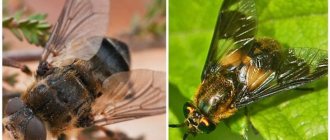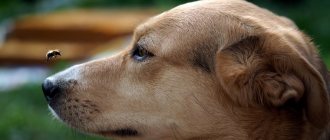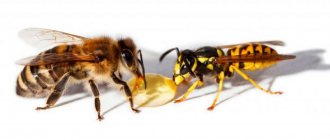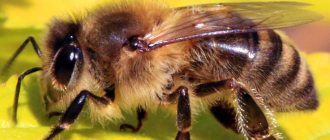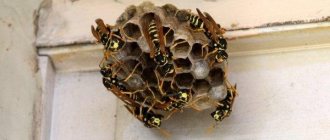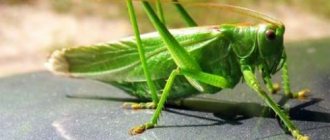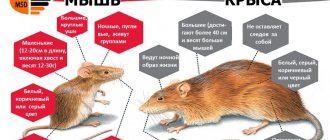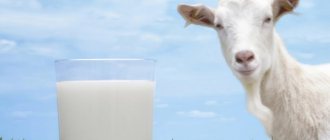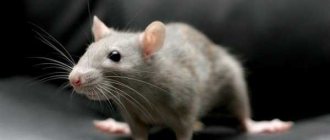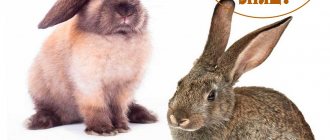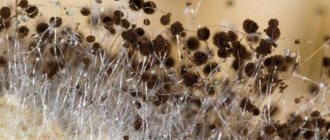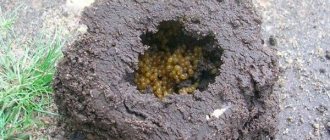Unenlightened sweets lovers are interested in the question: “Do bumblebees make honey?” For hairy insects, collecting nectar and making honey is not the main business of life. With their long proboscis, these beneficial insects pollinate many types of garden and vegetable flowering plants.
Pollen is carried by bumblebees thanks to the convenient devices given to them by nature, located on their hind legs. Bumblebees collect honey in small quantities to feed their larvae.
What you need to know about bumblebees
Despite their similarity to bees, bumblebees have a number of characteristic features.
It is in their habitat that their dissimilarity is most clearly manifested. Hypersocial bees live in hives with tens of thousands of their fellow bees. These hives can be either domestic colonies maintained by beekeepers or wild ones. Because bees produce honey, their long-lived colonies survive the winter quite well. A queen bee can essentially live for three to four years.
Bumblebees are also social, but not to the same extent. Unlike bees, which build hives, bumblebees live in nests with only a few hundred other bees. These nests are found exclusively in the wild (bumblebees are not domesticated) and can often be found in burrows or holes in the ground. In fact, the queen bee, which is the only member of the bumblebee colony to survive the cold season, overwinters in the ground.
Pollination and feeding
Of the two groups, bumblebees are the best pollinators. They can feed on more types of flowers than bees. They also work quite quickly and can carry large loads due to their large bodies.
Bumblebees are good at learning to extract pollen from different flowers and can even specialize in certain species. This “flexibility” makes bumblebees capable of cross-pollination, which is especially important for fruit trees. In addition, bumblebees are more resistant to weather conditions, cold, rain and limited lighting.
The only advantage honey bees have is communication. They are excellent at telling their colleagues where good pollen supplies can be found. While this is good for their colonies and honey production, it is actually more of a disadvantage from a pollination standpoint. While honey bees tend to cultivate a specific source of pollen, bumblebees can patiently cultivate a large area of land until it is completely pollinated, regardless of the type of plant.
Price
Firstly, bumblebees produce honey in very small quantities, and secondly, to obtain this product, much more effort is required. It is not surprising that the price of bumblebee honey is very high. One kilogram of such a product on specialized sites can cost about 5,000 rubles. When buying honey, there is always a high risk of running into counterfeit honey, so you should only trust sellers offering a certified product.
People know little about the life of bumblebees. Watch them fly and land on flowers in the garden. But I never got to see their “hives” in their usual form. They simply do not exist - insects live in nests and hollows, often located in places inaccessible to humans.
What's the deal with honey?
You can come across various statements regarding whether bumblebees produce honey or not. The truth is that the product produced by bumblebees cannot actually be called honey. Insects, like bees, collect nectar from plants. Thanks to the special elongated structure of the proboscis, it is even easier for them to do this than their honey-bearing counterparts. After which the nectar is also slightly processed using special bumblebee enzymes. However, this product is very different from bee honey, since it does not need to be stored throughout the winter. Therefore it is less fermented.
In addition, there is relatively little of it. Since the average bumblebee family consists of about 100-200 individuals, there is a very small amount of honey in the nests.
Working females are the most numerous in bumblebee hives. Their main task is to provide the family with nectar. The brought substance is fed to the members of the colony. Therefore, the well-being of the entire family directly depends on how efficient these individuals are.
The family’s greatest need for “honey” arises in the spring and autumn. The queen is most active at this time and constantly replenishes the hive. At this stage, the hatched larvae need feeding. However, further, at the end of the period of activity, the active queen dies, like the entire family. Only young queens survive, but they spend the winter in hibernation, so they do not require food during this period.
It is precisely because there is so little of it that bumblebee honey is considered a delicacy. Of course, it can be purchased from some enthusiasts, but its price is very high.
Beneficial features
A liter of bee honey is as healthy as 100 grams. bumblebee delicacy. Bumblebee honey is more valuable.
The delicacy has medicinal, dietary, restorative and anti-inflammatory effects. When nectar enters human food, it:
- prevents the death of brain cells;
- replenishes the amount of vitamins BB, A, C, E;
- saturates with carbohydrates;
- reduce appetite;
- will help if a person has problems with the gastrointestinal tract or respiratory tract diseases;
- helps in the prevention of atherosclerosis and thrombophlebitis.
As mentioned above, honey contains bacteria. The content of microorganisms is high, and they do not bring much benefit. To prevent microorganisms from spoiling the overall impression of the product, store the product at a temperature of 1-2°C.
Features of bumblebee honey
Bumblebee honeycomb
The uniqueness of this honey begins with the container. Unlike regular honeycombs, bumblebee honey is contained in larger “containers.” Their shape expands downward. In this regard, after sealing, such containers look more like bags.
It is almost impossible to see a bumblebee nest in nature and taste the contents of such honeycombs. Under natural conditions, families settle in burrows, holes, birdhouses and other secluded dwellings of wild animals.
Characteristic differences
Naturally, such a product is very different from the usual bee product in several ways:
- Variety of shades . Since bumblebees pollinate many more plants than bees, the composition of honey is much more diverse. This is reflected in the taste. If the so-called monosorts are quite common among bee products, then the bumblebee works for all the flowers in the area, without particularly sorting. Predicting the flavor is also quite difficult. For example, if a beehive is located next to a linden tree, then in most cases the honey will taste exactly like that. As for bumblebees, even if their nest is located next to a linden tree, the insect will still collect pollen from the entire area.
- Consistency . It is more liquid and contains less sugar. When collected, it is pumped out of the honeycombs using a pipette or similar device.
- Simplicity of taste . Bumblebee honey does not undergo such a complex processing process as bee honey. We can say that it is prepared according to a simpler “recipe”. Therefore, it is not such a “gourmet” delicacy.
- Storage conditions . Bumblebee honey is subject to fermentation to a greater extent than bee honey, since the nectar does not undergo complex fermentation processes and should not be stored throughout the winter. As a result, at temperatures above 7-8°C, honey can ferment.
Bee bread
Properties of dead bees
Unique properties of bee pollen
Royal jelly
Properties and composition
Bumblebee honey is as healthy as bee honey. However, at the same time, its composition is distinguished by the presence of a larger amount of proteins and minerals. These indicators are twice as high as those typical for bee honey. In addition to valuable minerals, the bumblebee product also contains a lot of pollen from medicinal plants.
Therefore, it is recommended to use it for digestive disorders, diseases of the respiratory system, liver, etc. Despite the fact that it is less sweet than bee, it is quite nutritious and high in calories.
Application
Bumblebees collect a treasure trove of natural products. A typical glass of liquid nectar contains 1166 kilocalories. It perfectly fills with energy, useful minerals, amino acids, and copes with male ailments (decreased potency, prostatitis).
One tablespoon of bumblebee product per day provides the human body with the missing useful minerals, vitamins of groups A, B, C, E. It is recommended at night for effective sweating.
Important! There is no need to heat bumblebee honey to temperatures above 50 degrees, destroying its beneficial properties. The optimal storage temperature is from 1 to 3 degrees Celsius. It is better to store in glass containers.
How to try bumblebee honey
It is indeed very difficult to find such a product on sale, and there is a high risk of purchasing a fake at an exorbitant price. However, there is an easy way to try bumblebee honey in nature. You don't have to be a professional beekeeper to do this.
Bumblebee house
To breed bumblebees artificially, you will have to work hard to attract them to the site. To do this, you need to build them a house, and garden flowers and fruit plants can play the role of an attractant.
A hive can be made from:
- birdhouse;
- hollows;
- big pot.
Any capacious container can be used as a nest. The main rule is to leave a small gap open, which will serve as a tap hole.
You can also make a professional beehive house. It is better to put it together from boards up to 2 cm thick. The top must be removable. Slots should be made in it for the tap hole and painted black. This technique will attract queen bumblebees.
Expert opinion
Smirnov Dmitry Filipovich
Experienced beekeeper who knows everything about honey and the life of bees
To locate the hive, you should choose only a dry place.
Hive protection
The hive must be protected from bad weather. To do this you need:
- Insulate it with filler. You can use foam, moss, mouse nests. You should avoid materials such as cotton wool and tow. Insects often get confused in them and die.
- Line the bottom with a layer of dry sawdust up to 3 cm.
- Cover the entrance from the rain. It is convenient to use a small piece of plank placed on the bricks.
- Prevent wax moth invasion. To do this, place 2-3 tablets of an insecticide specifically designed for these insects on the lid. The usual "Antimol" will do.
- Install a bumblebee drain. It will help prevent mice, ants, wasps and bumblebees from invading without a family.
- Protect the hive from the wind. To do this, you need to place small stones around the edges (and on the lid).
- For convenience, place the hive on support posts at a distance of half a meter from the ground.
Under natural conditions, bumblebees prefer to settle in mouse holes. To attract them, you can use an attractant with a specific mouse odor.
There is no need to rush; queen bumblebees usually populate artificial nests by mid-summer. Even if it doesn't work out, there's a good chance the hive will come in handy next year.
If the family has inhabited a mouse nest, you can carefully place it in a box with pre-made holes for the entrance and move it to your site.
why they don’t breed bees like bees, how to breed them yourself
A garden that blooms profusely in the spring may disappoint at the end of the season with a small harvest of average taste. This happens due to insufficient pollination of plant flowers, because most fruit trees are self-sterile.
Pollination is especially poor in cold and damp spring, when a heat-loving, multi-thousand-strong bee colony does not fly out of the hives.
Bumblebees are one of the most cold-resistant insects, due to the ability to warm up their body and the presence of thick hairs on it that protect the insect from bad weather.
Breeding bumblebees
A beneficial pollinator can fly out to collect pollen at temperatures from +2C°, in the rain, and also, thanks to good eyesight, in the dark.
The industriousness of bees is widely known, but the bumblebee pollinates 5 times more flowers per day and works 18 hours a day throughout the summer.
Beneficial pollinators are bred both for agribusiness and in private farms, including for pollinating greenhouse plants. Bumblebees require little care and are less aggressive than bees.
Important! As a result of plant pollination by bumblebees, a good harvest is guaranteed.
How to breed bumblebees
In order for a bumblebee family to appear on the site, you need to attract the bumblebee queen while she is looking for a nest.
They look for the queen insect in early spring; you can recognize it by the absence of pollen on its hind legs and circling close to the ground. The presence of pollen indicates that the female has already created a nest and will not do it again. The successor of the family can be caught by covering it with a box, and you can also buy it along with a ready-made house for bumblebees.
Growing beneficial pollinators is possible in industrial conditions, just as raising bumblebees on your own plot does not cause any particular difficulties.
The queen bumblebee is placed in a hive and closed there for a day. The female very carefully chooses the location of the future nest, so she may not like the proposed house, and after the opening of the entrance she will not return. This should be taken into account in order to understand how to breed a bumblebee in the garden. The colonization of a couple of ten hives is considered successful.
Interesting. Breeding bumblebees is also beneficial because wasps do not settle in their habitat.
Bumblebees live in families of 100-200 pieces, the number depends on the size of the nest, reproduction occurs throughout the summer season.
You can find out whether the female has moved into the proposed housing a few weeks after her placement; until this time she may not be detected, because the insect will be setting up a nest and hatching its first offspring.
Bumblebees that have settled in the hive first pollinate nearby plants, collecting all the nectar from them, and gradually increase their flight radius.
During the summer season, you can see dead bumblebees near the hive; this is a biological feature of insects; thus, females are renewed.
Bumblebee hive
Why aren't bumblebees bred like bees?
The behavior of bumblebees is unpredictable, they can leave the nest, and it is not possible to control the process. Fear of bites from nearby habitats of striped insects may also be the reason why no one breeds bumblebees.
Also, the difference between the bumblebee family and the bee family and the reason why bumblebees are not bred like bees is that this type of beneficial insect lives for one summer season. In the fall, all bumblebees die, and only a few females remain for the winter, which were born at the end of the season and were fertilized. Next season, it is these young females that will reproduce a new swarm.
In the fall, the successors of the bumblebee family burrow into the turf and hibernate there until next spring. In early spring, when moisture from melting snow appears on the female, she wakes up, begins to look for a place for a nest again and starts a family.
Interesting information! But bumblebees are calmer than bees, they sting only in case of danger and fly out of the hive not in a swarm, but one at a time.
How to breed bumblebees for honey
Bumblebee farming is mainly used for the purpose of pollinating crops, and not for breeding bumblebees for honey, the possible collection of insect honey is only an addition. Due to the short life span of a bumblebee colony, it does not need to store large amounts of supplies. Insects use nectar to feed their larvae, from which bumblebees emerge.
Bumblebees do not build honeycombs in the nest, like bees, but create small wax cups that are located at the bottom of the nest, in which the offspring are raised. Insects add processed nectar to the calyxes. Its quantity is insignificant for human collection, so breeding bumblebees for honey is not considered profitable.
Interesting. Bumblebee honey has a much higher content of proteins, minerals and vitamins, which is why it is considered a natural energy drink.
Bumblebee honey has a thinner consistency, similar to syrup; it is less sweet and fragrant than the usual bee honey. Because bumblebees are not picky in choosing which plants to pollinate, honey contains a combination of different flowers.
Even after eating a small amount of honey, you feel a surge of strength. Such honey is difficult to preserve - due to the high water content, it quickly deteriorates.
Note! Bumblebees are also difficult to breed for honey because the queen bumblebee may not return to her original position the following season.
How to make a house for bumblebees
To build a bumblebee house with your own hands, drawings may not be required. The hive is a box measuring 15-20 cm on all sides.
DIY hive
The box can be made from wooden boards, the bottom and lid from plywood. The inner walls are not planed to make it convenient for insects to crawl on them.
The lid should be removable and fit over the box. Two holes, 2 cm in diameter, are drilled in the middle of one of the walls, into which bumblebees will fly. A flight board or tube is nailed to the hole.
Interesting. The black entrance will attract the female, who will explore all the dark spots in search of a nest.
Moss, tow or fluffed cellulose wool are placed inside the box, which will serve as a covering material. The hives are placed on pegs, which need to be coated with grease to prevent ants from getting inside. The hive is installed with an entrance on the south side, closer to the fruit bushes. To prevent the hive from overheating, you can cover it with a sheet of foam plastic on top, but it is better to place it in the shade, because the female bumblebee does not like high temperatures in the nest.
It is recommended to install hives in groups of three to ten pieces, arranged in a row or in several tiers. The distance in the row is maintained at 2-2.5 m from each other.
Bombidarium of bumblebees
Bumblebees in natural conditions love to settle in abandoned rodent burrows. Therefore, along with above-ground ones, underground nests are also installed, which are called bombidariums. To install a bombidarium for bumblebees underground, you need to dig a hole the size of the box.
Bombidarium of bumblebees
Departure from the underground nest is carried out through a long flight tube, simulating an underground passage. The tube can be made from slats or take a plastic one of small diameter, about 1 m long. The tube is tightly attached to the tap hole and all connecting seams are covered with clay so that ants do not climb into the nest. The box is wrapped in plastic film.
A groove is dug to accommodate the tube. After installing the bumblebee house with a flight tube in the dug holes, the structure is covered with a small layer of earth and covered with turf.
All contents are removed from the nest vacated after the summer season and burned, and the boxes are disinfected from parasites. In early spring, new filler is applied.
Important! In the spring, the bumblebee queen will return only to a bumblebee habitat that is comfortable for her.
Bumblebees are excellent pollinators, thanks to their elongated proboscis, they are able to collect nectar from parts of the plant inaccessible to bees. The beneficial effects of insects on the garden and greenhouse plants speak only in favor of bumblebee farming.
Questions and answers
How can you give your hive a strong rodent smell?
The nesting material that will be used in the hive must be placed in a nest with mice or hamsters for a couple of days.
Are bumblebees more aggressive than bees when collecting honey?
Bumblebees will sting when defending their nest, so it is better to get protective clothing. In other cases, they are less aggressive than bees.
Does bumblebee honey cause allergies?
Bumblebees also belong to the family of true bees, so if you are allergic to regular bee honey, it is better to refrain from consuming bumblebee honey.
How much honey can you collect from one bumblebee nest?
At best, you will be able to collect a few glasses.
Is it possible to distinguish real bumblebee honey from a fake?
It is almost impossible to do this. The only way to tell the difference is by taste.
Contraindications
But there are also a number of contraindications to consuming bumblebee honey. People who suffer from diabetes are not recommended to consume bumblebee honey. Allergy sufferers should be careful when consuming it, as its allergenic potential is high. Of course, individual tolerance matters.
Therefore, before introducing bumblebee honey into your diet, it is advisable to try it in small quantities. If the body reacts normally, you can safely include this product in the menu. Despite a number of contraindications, this product is rich in beneficial microelements and replenishes the energy reserves of the human body.
Bumblebee honey is a very high-calorie product, so if you want to lose weight, it is not recommended to include it in your daily diet. One teaspoon of bumblebee honey contains 239 kcal.
The product contains a large amount of copper, zinc, potassium, and iron.
First aid for a wasp sting victim
Make soda lotions - dissolve 1 teaspoon of soda in half a glass of water, soak a cotton swab and apply to the wound, take an antiallergic drug (suprastin, diphenhydramine, diazolin, etc.), and in case of a very strong reaction, the hormonal drug hydrocortisone.
Some recommend immediately after a sting, rub the wound with garlic, onion or parsley - this should relieve the swelling; you can apply a cotton swab with ammonia diluted 1:5 with water. If the bitten person develops swelling of the facial tissues, bronchospasm, rapid heartbeat, convulsions, pain in the lower back, joints, or heart area - without wasting a second, call an ambulance.
Characteristics of honey
Externally, the health elixir looks like syrup - liquid, light yellow, and tastes like nectar, but with a more beneficial effect on the human body. Bumblebee honey is stored in combs in smaller quantities than beekeepers usually collect from the hive. This is due to the lifestyle of insects. They collect pollen only for the winter.
The honeycombs of bumblebees have a pitcher-like appearance that is unusual for many. They hold a large amount of product: in one season, bumblebee breeders collect a maximum of 7 kg of honey from one family of insects. The bee stores 9 times more nectar. The most liquid consistency of the product is produced by bumblebees of the Bombus Agrorum species.
To properly store nectar, you need to follow some rules. It is advisable that the container be glass or clay and not stand open. The best place for storage is a refrigerator with a temperature setting of at least 2°C. There should be no toxic products near the jar. In direct sunlight, honey will ferment faster.
The chemical composition contains:
- proteins;
- minerals;
- starch;
- water;
- bacteria.
The minerals that make up the nectar of this species are zinc, cobalt, copper. One tablespoon of bumblebee honey contains 97.2 calories (calculated per spoon containing 30 grams of product).
Origin of the species
The first species of bumblebees appeared millions of years ago
Scientists believe that bumblebees appeared about 30 million years ago, during the Oligocene period. But the found remains of insects from that time are poorly preserved, and the data obtained during the study is not enough to prove their belonging to this species.
Interesting fact: Most insects of the past are studied based on species found in tree resin. But bumblebees, due to their large size, do not fit in a drop of sticky substance, so finding their fossils is a great success.
The oldest insect remains that are definitely bumblebees date back to the Miocene and are approximately 20 million years old. It is believed that this species of bees originated in Asia, from where it gradually moved to Europe. After some time he reached America.
Over the past two centuries, a dozen remains of bumblebees have been discovered, which are from 10 to 20 million years old. Moreover, discoveries were made all over the world, on different continents.
